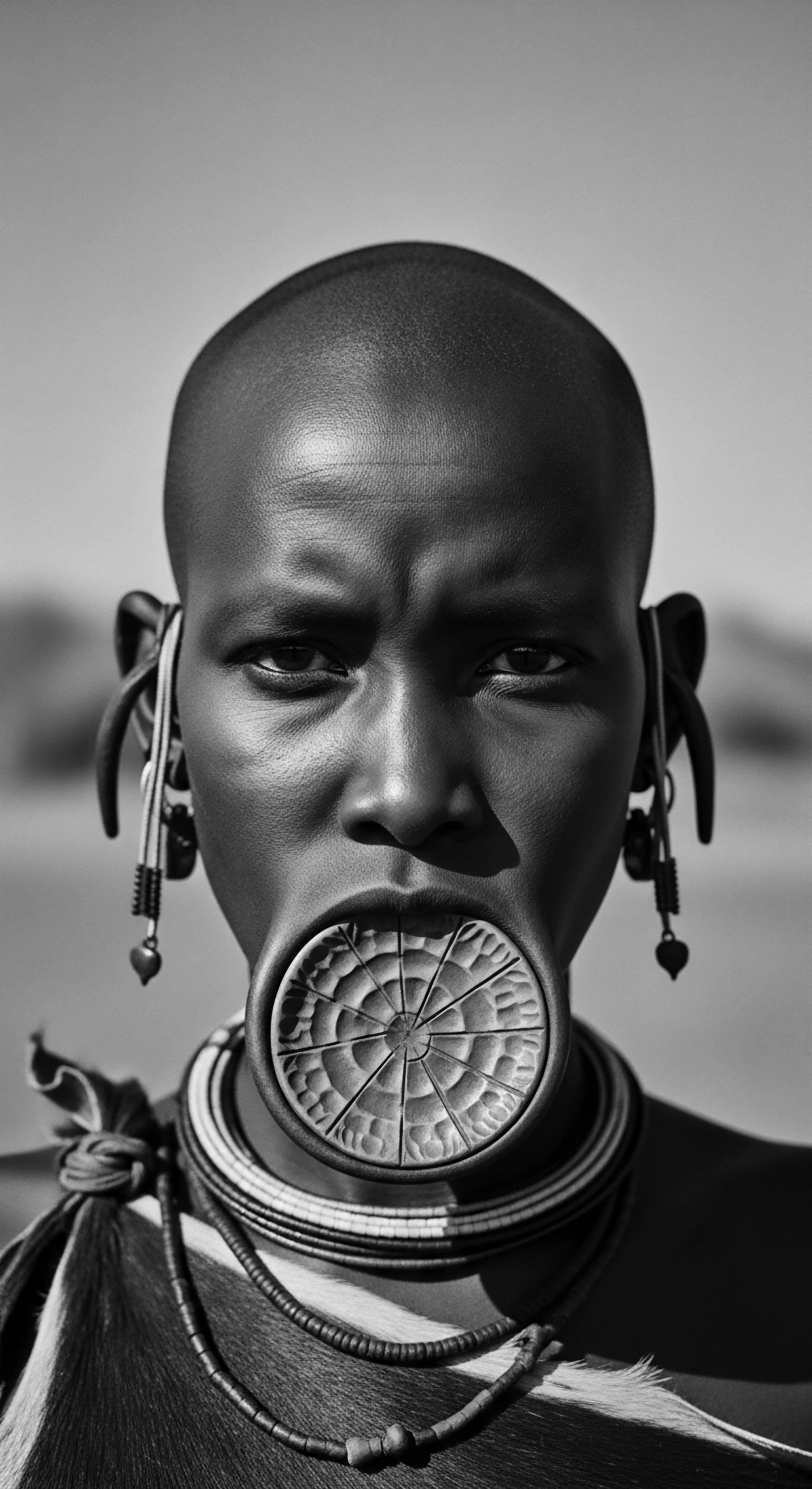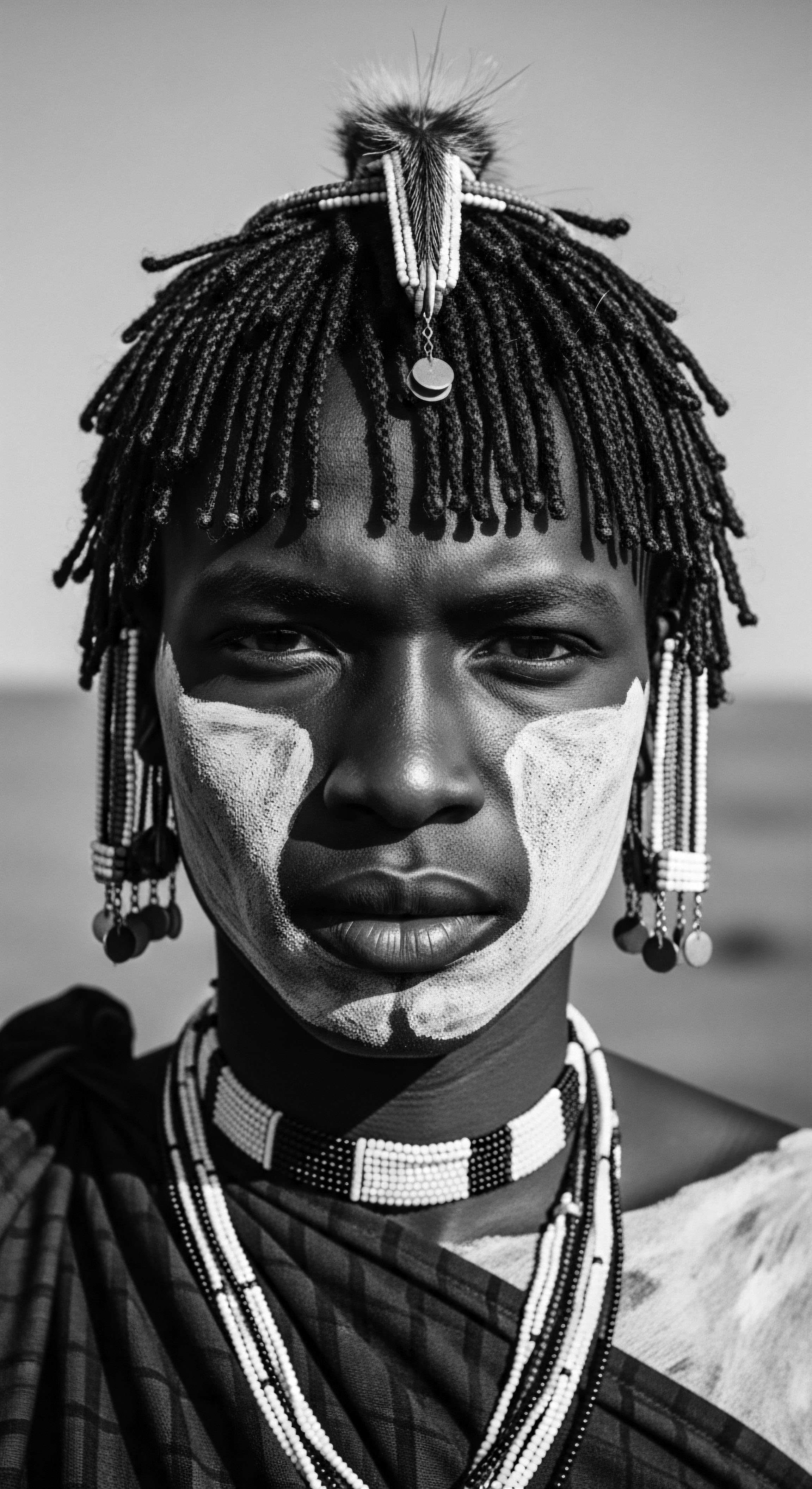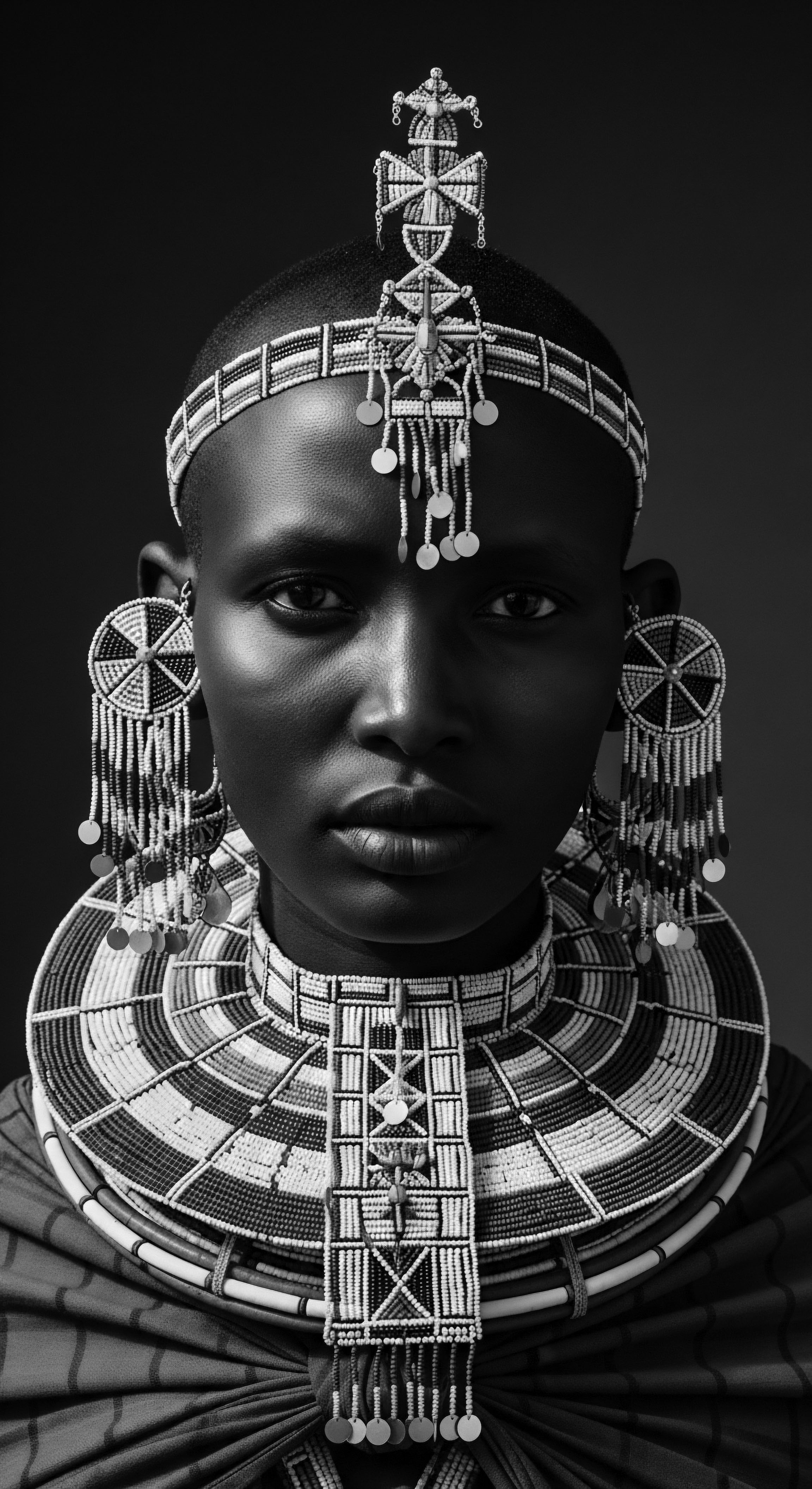
Fundamentals
Southern African Archaeology, a vibrant field of inquiry, speaks to the deep rhythms of human existence across the southern reaches of the African continent. This discipline involves the careful recovery, meticulous analysis, and thoughtful interpretation of material remains left behind by ancient societies. Its fundamental aspiration centers upon reconstructing the past, unraveling the intricate lives, cultural practices, and environments of those who walked these lands millennia ago.
From the earliest hominin footprints etched in ancient sands to the sophisticated kingdoms of the Iron Age, archaeology in this region offers a window into the unfolding narrative of humanity itself. It provides tangible evidence of how communities adapted, innovated, and expressed their understanding of the world through the objects they made, used, and sometimes, revered.
For those who seek to understand the textured hair heritage, Southern African Archaeology offers an illuminating perspective, connecting us directly to ancestral practices of adornment, self-expression, and community identity. Our hair, a living crown, carries echoes of these ancient customs, retaining the memory of hands that braided, coiled, and styled for reasons deeply embedded in cultural significance. The archaeological record here extends beyond mere survival, revealing a rich tradition of personal ornamentation that often included hair. Artifacts such as bone hairpins and an array of beads from various materials underscore a longstanding human desire to beautify and communicate through bodily expression.
(Tiley-Nel, 2007). These historical fragments remind us that human connection to self and community, articulated through personal appearance, possesses an ancient lineage.
The study of these ancient material traces allows us to grasp how communities understood their place in the world, often expressing complex social values and spiritual beliefs through their visible presentations. Hair, in its many forms and adornments, served as a powerful medium for conveying status, age, gender, and communal belonging. It was a canvas for creativity and a marker of identity, a heritage that pulses through generations, connecting contemporary hair practices to the wisdom of antiquity.

Early Echoes of Adornment
Evidence of personal adornment stretches back deep into the Middle Stone Age in Southern Africa. Consider the remarkable discovery of shell beads at Blombos Cave, dated to approximately 76,000 years ago (Henshilwood et al. 2004).
These early ornaments, crafted from tiny Nassarius kraussianus shells, carry perforations indicating they were strung together and worn, suggesting an early capacity for symbolic thought and self-expression. While not directly tied to hair, such finds lay the groundwork for understanding the human impulse toward ornamentation and the development of aesthetic sensibilities, which undoubtedly extended to hair.
The sheer duration of human presence in Southern Africa, spanning hundreds of thousands of years, means that the archaeological record presents a complex, multi-layered story. From the earliest use of ochre, a vibrant iron-rich pigment, by early Homo sapiens around 500,000 years ago, its application was not solely artistic. (Watts, 1999). Ochre served multiple purposes, including functional uses as sunscreen, an aggregate in hafting glues, and for hide-tanning (Hodgskiss, 2018; Lombard, 2007).
Its widespread use, becoming habitual approximately 160,000 years ago, suggests a deeper symbolic value and connection to ritual behavior (Hodgskiss, 2018; Watts, 1999; Stiner, 2017). This ancient pigment holds profound relevance for hair heritage, given its continued use by communities like the Himba, who traditionally coat their hair with red ochre paste mixed with butterfat, a practice signifying connection to the earth and ancestors.
Southern African Archaeology reveals the deep human connection to adornment and identity through hair, tracing practices back to ancient times.

Tracing Ancestral Hands
As we trace the lineage of human ingenuity, archaeological findings often point to the resourceful crafting of tools from available materials. Bone tools, for example, were important implements in various periods. In the Iron Age, bone was a common choice for a wide array of implements, including hair combs and snuff spoons, some of which continued to be made and used well into the 20th century.
These objects offer a tangible link to the intimate, daily rituals of personal grooming and aesthetic expression that existed long before colonial encounters. They remind us that the care and styling of textured hair are not recent inventions but practices honed over countless generations.
The careful excavation of burial sites in Southern Africa also yields invaluable insights. The inclusion of personal adornments with the deceased speaks volumes about social values, status, and beliefs surrounding life and passage. For instance, at Mapungubwe, a 13th-century Iron Age kingdom in Limpopo Province, archaeological recoveries include a variety of objects associated with women, such as decorative glass beads woven into traditional dress and hair. These discoveries confirm that hair, as a site of adornment, held significant cultural weight and was integral to the visual language of these ancient societies.
- Ochre ❉ An iron-rich pigment used for diverse purposes from hafting adhesive to personal adornment and spiritual rituals.
- Beads ❉ Crafted from shell, ostrich eggshell, glass, bone, ivory, copper, and gold, beads marked status, wealth, and identity within hairstyles and other adornments.
- Bone Tools ❉ Implements, including hair combs, show consistent attention to personal grooming and styling.

Intermediate
Southern African Archaeology, when viewed through the lens of textured hair heritage, offers a nuanced understanding of early human expression and societal structures. It moves beyond a mere chronicle of artifacts, inviting us to contemplate the profound meanings embedded within the tangible remnants of ancestral lives. The archaeological record here serves as a silent witness to millennia of human creativity, where hair and its adornment stood as powerful symbols of identity, community ties, and spiritual connection. This exploration is not simply academic; it calls us to recognize the enduring legacy of practices that shaped and continue to influence how Black and mixed-race communities perceive and care for their hair.
Understanding Southern African Archaeology requires acknowledging its deep temporality, stretching back to the Middle Stone Age (MSA). This period, roughly 300,000 to 30,000 years ago, witnessed significant advancements in human cognitive and behavioral complexity. Evidence of systematic ochre use became prevalent around 160,000 years ago, marking a phase of habitual engagement with this versatile pigment. Ochre was not merely a coloring agent; its diverse applications, from tanning hides to creating adhesives for tools, speak to a sophisticated understanding of material properties.
(Lombard, 2007). In the context of hair heritage, this signifies a long history of utilizing natural substances for both practical care and aesthetic enhancement, echoing the ancestral wisdom that informs many contemporary natural hair practices.
The intricate history of Southern African archaeological discoveries reveals deep societal values expressed through personal adornment, particularly hair.

Cultural Cartographies of Hair
The archaeology of Southern Africa illustrates how hair became a distinct medium for cultural communication. In precolonial societies, hairstyles transmitted intricate messages regarding tribal affiliation, social standing, age, marital status, and even spiritual beliefs. This rich semiotic landscape of hair is evident in the materials excavated from sites across the region. At Mapungubwe, a prominent Iron Age site, the sheer volume of imported glass beads, often used in hair adornment, underscores the wealth and social stratification of its inhabitants.
For example, a single female royal burial on Mapungubwe Hill contained over 28,000 black trade glass beads, likely originating from Egypt, demonstrating the immense social importance of the deceased and the value placed on such adornments. (Tiley-Nel, 2007). This specific instance illuminates how material culture, in the form of hair beads, functioned as a powerful signifier of elite status, directly linking archaeological findings to the cultural significance of hair within a sophisticated ancient kingdom.
The meaning of these adornments was often woven into the very fabric of society. Beads, for instance, held symbolic meanings based on color, with white often denoting purity, black linked to ancestors, and green signifying fertility. Such detailed symbolic systems applied to items worn on the body, including hair, illustrate a conscious effort to communicate complex social realities through personal appearance. The continuous tradition of adorning hair with various materials across different historical periods suggests that hair care was not merely about hygiene but served as a profound expression of self and community identity.

Technological Ingenuity in Hair Care
Archaeological investigations also uncover the ingenuity behind ancient hair care tools. While less common than stone tools, bone implements, including combs, have been found in various Southern African Iron Age contexts. These combs, some of which continued in use into the 20th century, provide a tangible link to the daily practice of detangling, styling, and maintaining textured hair. Their presence indicates a consistent cultural value placed on hair grooming, reflecting an understanding of hair health and aesthetics.
Moreover, the broader archaeological understanding of composite tools, where multiple components were combined, offers insight into the potential complexity of ancient hair styling. Just as small stone bladelets (microliths) were hafted onto projectiles, signifying advanced technological thought, it is plausible that ancient hair tools also involved compound designs or the combination of various elements to achieve desired styles or care rituals. The evolution of such tools reflects a deeper cognitive capacity for problem-solving and an artistic sensibility applied to personal expression.
The San people, ancient hunter-gatherers of Southern Africa, depicted their world in exquisite rock art, offering visual clues to their personal adornment. While interpretations vary, these paintings provide insight into body symbolism and potentially hairstyles or headdresses. The connection between dress, ornamentation, and social relationships within San society is becoming clearer, suggesting that their visual communication, including how bodies and hair were represented, was deeply meaningful.
(Viestad, 2023). This intertwining of art, daily practice, and profound meaning underscores the enduring significance of hair as a cultural artifact in Southern Africa.
| Material Ochre (red, yellow, brown pigments) |
| Archaeological Context / Location Blombos Cave (MSA), Himba practices (present) |
| Cultural Significance / Hair Connection Symbolic value, ritual use, skin and hair protection, aesthetic enhancement (e.g. Himba hair paste) |
| Material Glass Beads (traded and reworked) |
| Archaeological Context / Location Mapungubwe, K2 (Iron Age) |
| Cultural Significance / Hair Connection Denoted status, wealth, integral to traditional dress and hair adornment; colors held symbolic meanings |
| Material Ostrich Eggshell Beads |
| Archaeological Context / Location Blombos Cave (LSA), Khoesan communities |
| Cultural Significance / Hair Connection Among the earliest personal ornaments, strung as necklaces/girdles, sewed into head-ornaments and clothing |
| Material Bone Hairpins / Combs |
| Archaeological Context / Location Mapungubwe (Iron Age), various Iron Age sites |
| Cultural Significance / Hair Connection Tools for styling and maintaining hair, indicating attention to personal appearance |
| Material These ancient materials offer glimpses into the deep historical continuity of hair adornment as a marker of identity and cultural expression. |

Academic
Southern African Archaeology, a rigorous academic pursuit, delineates the systematic investigation, explication, and scholarly interpretation of past human societies within the expansive geographic and temporal scope of Southern Africa. This field transcends mere excavation; it engages with complex theoretical frameworks, multidisciplinary methodologies, and critical analyses of material culture to reconstruct the intricate social, economic, cognitive, and spiritual lives of ancient peoples. The meaning of Southern African Archaeology is inherently dynamic, continuously reshaped by new discoveries and refined interpretations that challenge preconceived notions of human behavioral modernity and cultural evolution. Its unique contribution to global archaeology lies in providing some of the earliest and most continuous records of Homo sapiens ‘ journey, particularly concerning the development of symbolic thought and complex social structures.
The field’s significance is profoundly amplified when examining the textured hair heritage, illuminating how ancestral knowledge and cultural practices concerning hair have been preserved, adapted, and transformed over millennia. This academic lens allows for a granular understanding of hair as a profound site of identity formation, social discourse, and spiritual practice, extending far beyond superficial aesthetics. It is a critical examination of how hair, in its biological composition and cultural manipulation, serves as a living archive of human experience in this distinctive region.

Reconfiguring Early Human Cognition through Adornment
The archaeological record in Southern Africa provides compelling evidence for the emergence of complex cognitive abilities far earlier than once hypothesized, a narrative intimately connected to the use of adornment. The site of Blombos Cave, in particular, offers a pivotal case study. Here, archaeologists have recovered not only deliberately perforated shell beads, signaling personal ornamentation (Henshilwood et al. 2004), but also sophisticated ochre-processing toolkits dated to approximately 100,000 years ago (Hodgskiss, 2018; Henshilwood et al.
2009). These toolkits, comprising abalone shells used as containers to mix ochre with crushed bone, charcoal, and quartz, demonstrate a multi-step process for creating pigments. (Rifkin, 2018). This evidence points to a capacity for planning, abstract thought, and the symbolic use of materials, considered hallmarks of modern human cognition.
The functional and symbolic uses of ochre, a ubiquitous find across Middle Stone Age sites, are subjects of ongoing scholarly discourse. While ochre undoubtedly served practical purposes, such as an adhesive for hafting tools or as insect repellent, its widespread presence and complex preparation suggest a deeper significance beyond utilitarian needs. (Lombard, 2007; Hodgskiss, 2018).
The consistent application of ochre in diverse contexts, including its documented use in hair by contemporary indigenous groups like the Himba, strongly indicates its role in personal and communal identity. This historical continuity provides a powerful ethnographic parallel, allowing us to interpret ancient ochre use in the context of hair as a deliberate act of self-expression and cultural affiliation, predating formal “art” by tens of thousands of years.

Hair as a Cultural Repository ❉ The Mapungubwe Example
The Iron Age site of Mapungubwe (AD 1220–1290), often considered the first kingdom in Southern Africa, provides a rich tableau for understanding the intersection of archaeological findings with textured hair heritage. The material culture excavated from this site, particularly from elite burial contexts, offers undeniable proof of hair’s profound social and economic value. (Tiley-Nel, 2007).
The extensive collection of glass beads, both imported from distant lands like India, Egypt, and Arabia, and locally reworked into distinctive “garden roller” beads, were not merely decorative. These beads were deeply woven into traditional dress, waistbands, necklaces, and, significantly, hair. The colors themselves held symbolic connotations ❉ white for purity, black for ancestral connection, and green for fertility.
This intricate system of adornment extended to men and women, with objects often buried with individuals to signify their high social standing. (Tiley-Nel, 2007).
A particularly illuminating example comes from a royal burial on Mapungubwe Hill, where a single female individual was interred with over 28,000 black trade glass beads. This staggering quantity of beads, imported from Egypt, underscores the immense social importance of the deceased and the integral role of such adornments in marking status and identity within this thriving Iron Age society. This singular archaeological finding provides robust empirical data, underscoring how hair, through its embellishment, served as a powerful declaration of one’s place within the societal hierarchy and spiritual realm. It speaks to a deep ancestral practice of personalizing and elevating identity through the elaborate styling and ornamentation of hair, a legacy that resonates within Black and mixed-race hair experiences today.
The vast quantity of black glass beads in a Mapungubwe royal burial highlights hair’s immense social value and its profound connection to ancestral identity.

Discourse on Identity and Appearance in the Archaeological Record
The archaeology of Southern Africa, particularly the study of physical attributes in ancient populations, offers important insights into the formation of cultural identity, a topic that directly informs our understanding of textured hair heritage. The term “Khoisan,” for instance, has been used broadly to describe groups with specific morphological and cultural similarities, including tightly spiraled hair often referred to as “peppercorn” hair. (Schepartz, 1999; Deacon & Deacon, 1999). While direct evidence of hair texture is rare in prehistoric skeletons, rock art and ethnographic parallels offer compelling insights.
San rock paintings, distributed widely across Southern Africa, offer visual narratives of their world, often depicting human figures with distinctive features and body ornaments. While their precise interpretation remains a subject of ongoing research, these artistic expressions likely reflect aspects of their social lives, rituals, and personal appearance. The San people’s deep connection to their environment and spiritual beliefs was often embodied in their dress and ornamentation, which likely extended to their hair.
(Viestad, 2023). Accounts of San practices, such as the burning of hair in rituals to bring rain, underscore the intimate and sacred relationship between hair, the body, and the natural world in their cosmology.
The study of bone tools, a significant aspect of Stone Age archaeology, further indicates a continuous history of grooming. Bone combs, identified at sites across the region and continuing into later periods, signify persistent attention to hair care and styling. These tools, often overlooked in broader discussions of technological advancement, were essential for maintaining the unique textures and intricate styles characteristic of African hair. They represent a fundamental component of ancient beauty rituals and self-care practices.
- Mapungubwe Gold ❉ Beyond beads, gold artifacts from elite burials, such as plaited gold bangles and gold beads, indicate immense wealth and status.
- Iron Age Metalwork ❉ Copper bangles, earrings, and hair ornaments were widely used, demonstrating sophisticated metalworking skills and their application to personal adornment.
- Pre-Colonial African Hairstyles ❉ They served as intricate communication systems, conveying marital status, age, social standing, tribal affiliation, and spiritual beliefs.
The profound meaning of Southern African Archaeology extends to the very structure of societal interaction, as evidenced by the strategic use of personal adornment. The distribution of particular types of beads, for instance, can map trade networks and the spread of cultural influence, indicating complex social connectivity across vast distances. (Tiley-Nel, 2007). This interconnectedness suggests that shared aesthetic values and grooming practices, including those related to hair, played a role in reinforcing social bonds and communal identity across diverse groups.
The archaeological findings, therefore, offer an exceptionally rich tapestry of human experience, one in which the styling and ornamentation of hair were never trivial. Instead, they were central to individual expression, social cohesion, and the spiritual understanding of the world.
The examination of ancestral burial practices also provides a fascinating avenue for understanding the symbolic treatment of the body and hair. While early hominin burials might have been pragmatic, later Middle and Upper Palaeolithic burials, including those in Southern Africa, show signs of intentionality and possible ritual significance. (Rifkin, 2018; Mithen, 1996).
Though direct hair preservation is rare, the grave goods often associated with these burials—such as ochre or personal ornaments—strongly imply a continued attention to the deceased’s appearance, carrying cultural meanings into the afterlife. This scholarly focus on the mortuary realm further underscores the deeply embedded role of appearance, including hair, in human cultures across time.

Reflection on the Heritage of Southern African Archaeology
Southern African Archaeology, when viewed through the compassionate lens of textured hair heritage, becomes a living, breathing archive of human ingenuity, resilience, and profound connection to self. It reveals a lineage of care that extends beyond survival, speaking to the soul’s ancient yearning for beauty, expression, and belonging. The whispers from ancient sites remind us that the intricate patterns and adornments of Black and mixed-race hair today are not mere trends; they are echoes of ancestral hands, of communities that understood hair as a sacred thread woven into the very fabric of identity. Each coil, braid, and loc carries the memory of shared wisdom, of a history where hair communicated status, spirit, and story, enduring through centuries of joy and struggle.
This journey through archaeological time underscores the enduring power of hair as a cultural anchor, a site where elemental biology meets sophisticated artistry and deep meaning. From the vibrant ochre that painted ancient strands to the precious beads that denoted royal standing, the archaeological record provides a tangible validation of ancestral practices. It offers a wellspring of affirmation, inviting us to appreciate the unbroken continuum of hair traditions that define and empower us. As we connect with these ancient rhythms, we find strength, a grounding presence that roots our modern hair experiences in a profound historical legacy, affirming the boundless beauty and wisdom inherited from those who came before.

References
- Henshilwood, C. S. d’Errico, F. Van Niekerk, K. L. Dayet, L. Queffelec, F. & Palamede, P. (2014). An Abstract Engraving on a Piece of Ochre from Blombos Cave, South Africa. Nature, 514(7524), 312–315.
- Hodgskiss, T. (2018). Ochre and the Earliest Uses of Colour. Discover Magazine, March 15.
- Lombard, M. (2007). The gripping nature of ochre ❉ The association of ochre with Howiesons Poort adhesives and Later Stone Age mastics from South Africa. Journal of Human Evolution, 53(5), 499-510.
- Mithen, S. (1996). The Early Prehistory of Human Social Behaviour ❉ Issues of Archaeological Inference and Cognitive Evolution. Proceedings of the British Academy, 88, 145-161.
- Rifkin, R. F. (2018). What the Ancient Pigment Ochre Tells Us About the Human Mind. Discover Magazine, March 15.
- Schepartz, L. A. (1999). Who were the latter Pleistocene eastern Africans?. Journal of Human Evolution, 36(2), 173-197.
- Sieber, R. & Herreman, F. (2000). Hair in African Art and Culture. The Museum for African Art.
- Stiner, M. C. (2017). The Emergence of Habitual Ochre Use in Africa and its Significance for The Development of Ritual Behavior During The Middle Stone Age. Archaeological and Anthropological Sciences, 9(7), 1361-1378.
- Tiley-Nel, S. (2007). Ancient artefacts, adornment and archaeology. Quest ❉ Science for South Africa, 3(4), 26-30.
- Viestad, V. M. (2023). Dress research may provide new perspectives on the rock paintings of the San people. University of Oslo News, November 13.
- Watts, I. (1999). The Origins of Symbolic Culture ❉ The Middle Stone Age of Southern Africa. Current Anthropology, 40(S1), S21-S37.
